FNR24150 Exam 1 Notes (copy)
Phylogeny of Amphibians
Oldest to most recent
Lissamphibia
Temnospondyli
Gymnophiona, Anura, Caudata (extant amphibians)
Why land?
unexploted food resources
aquatic habitat niches already occupied
lack of large terrestrial predators
largely primitive plants & invertebrates
low O2 in warm H2O (land O2 unlimited)
Early Tetrapods
Upper Devonian lobe-finned fish
pelvic and pectoral fins slowly transition to paired paddles
median fins still present
small ribcage
Carboniferous labyrinthodont amphibian
paired paddles slowly turn into limbs
larger ribcage to account for organs
More Phylogeny (indivudual spp. discussed further below)
Era: Paleozoic, Period: Devonian
Ichthyostega, Tiktaalik
Era: end of Paleozoic-beginning of Mesozoic, Period: end of Permian-beginning of Triassic
Triadobatrachus
Era: end of Mesozoic-beginning of Cenozoic, Period: end of Cretaceous-beginning of Tertiary
Extant salamanders & frogs
major evolutionary transitions in last 350 years
Amphibians were the dominant land animals for ~75 million years
Leposondyli
very small yet very diverse early amphibians
similar to newts, eels, snakes, lizards, etc.
Permian era
droughty conditions
reptile & early reptile spp. emerged and evolved
Tiktaalik
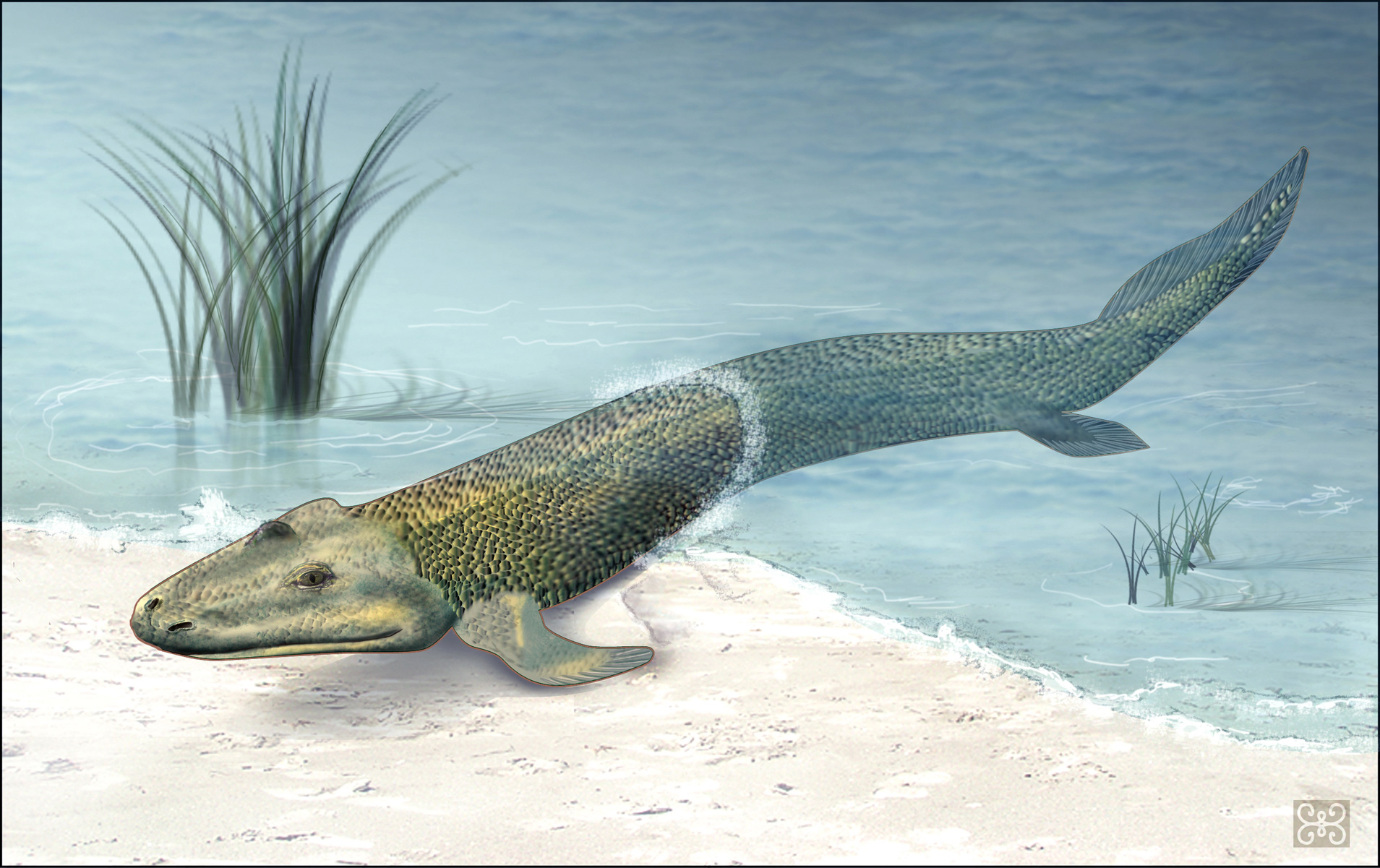
late Devonian (375 MYA)
discovered in Canada in 2004
predated Ichthyostega by 5 million years
thought to be the oldest up til this point
1-2m long
most notable feature: front pair fins with wrist-like structure
other features
spiracles (primitive nostrils)
lungs & gills
1st tetrapod with proper neck
greater flexibility during short bouts on land
Ichthyostega (“roof fish”)

late Devonian (370 MYA)
discovered in Greenland
5 ft, 50 lbs
fish & amphibian features
webbed feet
could breathe air for short periods of time
Eryops

Permian (270 MYA)
crocodile-like early amphibian
aquatic & terrestrial
had some structural features that would appear in later reptiles
Diplocaulus (“double stalk”)

middle-late Permian (240-230 MYA)
3ft, 5-10 lbs
wide V-shaped boomerang head
possibly used to navigate strong currents
facilitated rapid opening for suction-gape feeding
Frog Evolution Trends
several modifications for jumping
vertebral column short & inflexible
reduction in presacral vertebrae
found within pelvis (cervical, thoracic, lumbar)
increase rigidity, absorption of landing
transfer energy directly to hind limbs
enlarged pelvic girdle, strengthened & anchored to vertebral column
no ribs
no tail as adult
overall body truncated
hind limbs elongated for jumping
muscles modified for jumping
Amphibamus (“equal legs”)

late Carboniferous (300 MYA)
swamps in Europe & NA
6 inches, few ounces
more salamander-like than frog-like
33 presacral vertebrae
common characteristic of early amphibs (large amount of presacral vertebrae)
Gerobatrachus (“frogmander”)

early Permian (290 MYA)
found in Texas in 2008
why is it called “frogmander?”
2 fused ankle bones
backbone intermediate in length
decrease from 33 vertebrae in Amphibamus
large tympanum (large, external ear on frogs)
wide, frog-like skull
likely transitional
240-275 MYA splitting frogs & salamanders
Triadobatrachus (“proto frog”)

early Triassic (250 MYA)
found in Madagascar
first fossil frog
characteristics
short, stubby tails
10 cm
13-14 presacral vertebrae
9 in modern frogs
Viraella
early Jurassic (~200 MYA)
found in Argentina
earliest “true” frog
may belong to Leiopelmatidae (modern family)
classic frog-like head & large eyes
legs modified for jumping (explored in next point)
Triadobatrachus vs. Viraella

Vieraella more truncated overall
reduction in presacral vertebrae
enlarged & fused pelvic bones in Viraella
fused tibiofibula in Viraella
Paleobatrachus (“ancient frog”)


Cretaceous--Tertiary (130-135 MYA)
found in Europe
completely aquatic
inhabited swamp basins
volcanic gases preserved soft tissue
resembles present day Xenopus
Amphibians vs. Reptiles
amphibians
clawless
scaleless
moist skin (respiration)
unshelled eggs
reptiles
limbs & muscles
increased brain size (cerebrum & cerebellum)
more effective jaw
skeletal structure improved
skin toughened with scales
reduced cutaneous respiration
well-developed lungs
consequence of scales
amniote egg
no longer relied on water for breeding
arose from anthracosaurs (later tetrapods)
Order Caudata (Salamanders)
characteristics
smooth skin
long tails
long cylindrical bodies
most have 2 pairs of very well developed limbs
some have nasolabial groove
little groove that runs from nose to lips
costal grooves
body folds found on their sides
carniverous & cannibalistic
secretive & nocturnal
greater diversity in development, respiration, and reproduction than any other vertebrate group
nearly all salamander larvae have external gills
reabsorbed later
Sirenidae keeps external gills (paedomorphic)
habitat & distribution
common throughout U.S.
70% of ~400 spp. of salamander found worldwide are located in Central & NA
mostly found in moist woodland habitats
hardwood & coniferous forests, grasslands, lowland floodplains
highly dependent on precipitation, temperature, & vegetation type
Four-toed Salamander requires sphagnum bogs
22 spp. & 2 hybrid forms of the unisexual complex group are found in IN
some spp (Wester Lesser Siren) spend summers in estivation by encapsulating themselves in a mucous-lined cocoon
some permanently aquatic (ponds, lakes, & streams)
some terrestrial (under logs, leaf litter, rocks)
reproduction
ephemeral wetlands
breeding season: late winter--early spring
few breed in fall
courtship practices
nudging
tail & chin tapping
tail fanning
majority of salamanders have internal fertilization
male salamanders deposit sperm packets (spermatophore) which the females pick up with their cloaca
eggs are fertilized as they travel through the oviduct and encounter spermatophore
majority of salamander spp. are oviparous (lay unshelled eggs)
all IN salamanders are oviparous
some give birth to gilled larvae (larviparous)
others give birth to fully transformed young (pueriparity)
eggs prone to desiccation/drying out
must lay eggs either in moist soil or in water
most do not provide parental care
many do guard eggs
diet
carnivorous; mostly insects, spiders, & earthworms
occasional cannablism
Salamander Family Phylogeny
10 recognized families
60 genera
400 spp.
Sirenidae <3 & Cryptobranchidae most primitive
Polytomy
Proteidae
Amphiumidae
Plethodontidae
Rhyacotritonidae
ALL RELATED; UNKNOWN WHICH IS MORE DERIVED OR PRIMITIVE
Salamandridae, Dicamptodontidae, & Ambystomatidae
most derived (especially Ambystomatidae)
Sirenidae (“Sirens”) <3
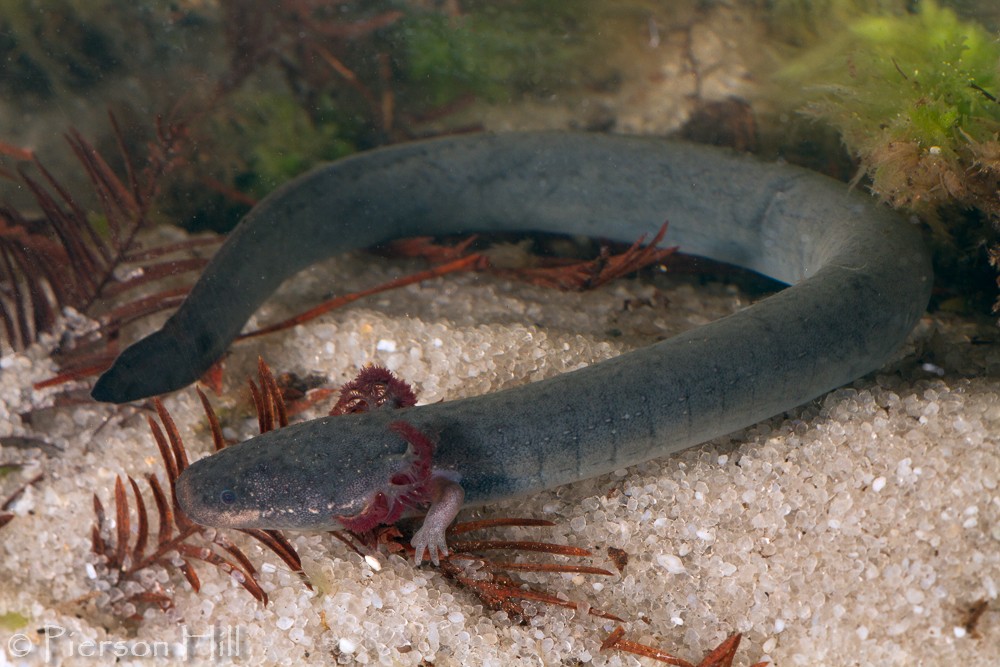
100 million years old--oldest extand Salamander families
4 spp. & 2 genera
characteristics
eel-like bodies & front limbs
has forelimbs; NO HIND LIMBS
paedomorphic
retain larval characteristics as adults
external gills
lack eyelids, premaxillary teeth, & hind limbs
nocturnal
distribution
fully aquatic
heavily vegetated, slow moving water
shallow water, swamps, ditches, ponds, etc.
found primarily in southeastern NA (not really common in IN)
reproduction
breeding season: early spring
200-700 eggs deposited to base of aquatic vegetation
may have external fertilization
special concern; may eventually become endangered :(
Cryptobranchidae (“giant salamanders”)

3 spp. & 2 genera
Eastern Hellbender (smallest)
found only in northeastern USA
Japanese Giant Salamander
Chinese Giant Salamander (largest)
1.5m & ~100 lbs
characteristics
paedomorphic
flattened body & head
skin folds for respiration
distribution
fully aquatic
cold, fast moving streams
cool shallow areas where rocks not embedded in substrate
essentially nocturnal
diet
primary: crawfish
fish, aquatic insects
reproduction
external fertilization
multiple females may lay eggs in one male’s nest (which are defended)
male fertilizes eggs; chases away female
eggs hatch in ~55-75 days
young remain in larval stage for 2 years
juveniles require an additional 3-4 years to reach sexual maturity
Proteidae (“mudpuppies”)

6 spp. & 2 genera
characteristics
similar to sirens, but have hind limbs
large, bushy external gills (paedomorphic)
caudal fins
4 toes
diet
insects & fish
distribution
fully aquatic
lakes, ponds, rivers, & streams
rarely seen in depths less than 1 meter
commonly found 20 meters below surface
found in central & eastern USA, southern Europe
reproduction
internal fertilization
males & females guard eggs
why “mudpuppy?”
stems from the erroneous belief that members of this family smit barking sounds when disturbed
special concern; may become endangered
Ambystomatidae (“mole salamanders”)
30 spp.
characteristics
stout bodies
thick, robust limbs
thick tails
short, blunt head
functional lungs
reproduction
breeding season: spring
males & females migrate in the hundreds to ephemeral ponds
lay eggs in water
stay in aquatic salamander larvae form for 4-6 months
metamorphose (indirect development)
leave aquatic environment
spend life on land
why “mole salamanders?”
comes from their habit of staying underground & in burrows of other creatures except when breeding
Plethodontidae (“lungless salamanders”)
2/3 of all salamander spp. belong here
characteristics
primarily breathe through moist skin
thin, elongated bodies
prominent coastal grooves
ONLY family with nasolabial groove
autotomize tail when attacked
distribution
diverse habitats
fully/semi/not aquatic
reproduction
internal fertilization
eggs hatch into mini adults (direct development)
diet
typically feed at night
insects, millipedes, worms, spiders, snails, & mites
Salamandridae (“newts”)
characteristics
thick, granular skin
granules due to numerous toxic glands
aposematic
bright coloration usually to deter predators
unken reflex
posturing areas laden with high toxicity
tetrodotoxin
neurotoxin used for chemical defense
distribution
live in forests
reproduction
lay eggs in water
eggs --> gilled larvae
partial transformation into red efts (2-3 years)
really bright skin
only terrestrial stage of newt
only found in this family
reach sexual maturity and spend life in water
distribution
found in eastern & western NA, Europe, Africa, & Asia
diet
eat invertebrates, amphibian, & fish eggs
Anuran Diversity (Anura = “without tail”)
currently 45 recognized families
~5,500 spp.
constantly changing taxonomy
spp. discoveries
genetic technologies
FROGS ARE LEAPERS; TOADS ARE HOPPERS
found on all continents except Antarctica
reproduction
metamorphose (indirect development)
only 4 spp. have tails as adults
usually external fertilization
diet
tadpole: herbivorous
adults: carnivorous
Scaphiopodidae (“Nearctic Spadefoot Toads”)
characteristics
circular/sickle-shaped hardened keratinous structure on hindfoot, forming a spade
transitional spp.; somewhat warty and smooth
vertical pupils
don’t have prominent paratid glands
glands that secrete toxic substance
distribution
found on tropical forest floors
NA, Europe, Asia, Africa
reproduction
breed in temporary ponds; highly accelerated development
diet
eat many insects
special concern
Hylidae (“Treefrogs”)
800 spp. & 45 genera
characteristics
smooth & somewhat warty
mostly well camouflaged (has flash colors though)
can have large or small toepads depending on habitat
distribution
most boreal, some aquatic or fossorial
NA, SA, Europe, Asia, Australia
reproduction
all return to water to breed
external fertilization
diet
carnivorous insectivores
Bufonidae (“Toads”)
~500 spp.
characteristics
thick, granular, warty skin
Bidder’s organ
vestigal ovary on larval testes
prominent parotid gland that secretes toxic substance
diurnal during spring & fall; mostly active at night in hot & humid weather
distribution
most are terrestrial or fossorial
reproduction
all return to water to breed
external fertilization
Ranidae (“True frogs”)
~300 spp.
characteristics
slim-waisted with long legs, smooth skin, & prominent tympanums
dorsal lateral skin folds on back or around tympanum
extensive hind feet webbing
aquatic & nocturnal
some fossorial, arboreal, or terrestrial
reproduction
eggs deposited in shallow pond or creek
tadpoles
froglets
frogs
diet
tadpoles: herbivorous
juveniles & adults: insectivorous
some can eat other frogs, turtles, small mammals/birds, etc.
Phylogeny of Reptiles
diverged from amphibians in Carboniferous era, Permian period (arid transition)
better fossil record
focus on
synapsids (archosaurians)
diapsids (archosaurians, lepidosaurs)
anapsids
Synapsids (“archosaurians”)
branched early on from amphibian line
completely terrestrial
shelled & amniotic egg
modern day mammal
Diapsids (“archosaurians, lepidosaurs”)
archosaurs
gave rise to modern birds & crocodilians
largely responsible for dinos
lepidosaurs
modern snakes & lizards (Jurassic)
Anapsids (“turtles”)
Triassic
basic body plan (stayed the same for millions of years)
Odontochelys
late Triassic (220 MYA)
discovered in 2008, predates Proganochelys by 10M years
“toothed shell”
found in E. Asia, shallow marine waters near shore
Proganochelys
late Triassic (210 MYA)
most well-known
“early turtle”
3ft, 75 lbs
possess few teeth
modern turtles lack teeth entirely
Jurassic
Eileanchelys
late Jurassic (165-160 MYA)
found in W. Europe (Scotland)
earliest pond turtle
discovered in 2008
Cretaceous
Archelon (marine turtles <3)
late Cretaceous (75-65 MYA)
found in oceans of NA
“Ruling Turtle”; 12 ft, 2 tons
large, flipper-like arms & legs
closest living relative: leatherback
Early Reptiles: Amniotes
Casineria: Early Carbnoiferous (340 MYA)
salamander-like early tetrapod
5 digits with claws
1st amniote
amniotes
eggs survive out of water
disperse onto drier land
1st Lizards, Hylonomus
Carboniferous (315 MYA)
discovered in Canada
characteristics
earliest known reptile
among first amniotes, anapsid
small, lizard-like (8-12 in)
fossil with distinct toe & scales
numerous sharp teeth (insectivores)
Mesozoic (“Age of Reptiles”)
explosive radiation of reptiles
most numerous & largest
dominant terrestrial & aerial animals
formidable marine predators
Archosauromorphs
“Ruling Reptiles” of Mesozoic
early diapsid amniotes
ancestral to crocodilians, birds, & turtles
Crocodilians
surviving archosaurs
early ancestors (Jurassic-mid Cretaceous)
Stomatosuchus
~36 ft
swamps, N. Africa
Sarcosuchus
“flesh crocodile”
~40 ft
“Super Croc”
Lepidosauromorphs
2nd major Diapsid lineage
ancestral to squamates (lizards, snakes), tuataras
first appeared late Permian
Tuatara (Sphenodontia)
living fossils; Triassic
extant; New Zealand
descended from beak-headed reptiles (Rhinocephalia)
Order Testudines (or Chelonia), Turtles
shells helped them persist for 200 MYS
400 spp.
distribution
aquatic, semi-aquatic, terrestrial
reproduction
oviparous (all lay eggs)
diet
most adults are omnivorous; some completely herbivorous/carnivorous
all turles lack teeth,
distribution
tropic & temperate
Testudines, Chelydridae (“snapping turtles”)


2 genera; Macroclemys & Chelydra
each with 1 spp.
characteristics
large, long tails
muscular legs
massive head
greatly reduced plastrons
nocturnal, fully aquatic
eggs on land
distribution
NA, SA, SEA
Testudines, Kinosternidae (“mud & musk turtles”)

4 genera, 23 spp.
characteristics
<6 in
glands on side produce musky odor
domed carapace & plastron (hinged)
distribution
semi-terrestrial
poor swimmers; walks along bottom of streams & ponds
prefer sandy or muddy dwellings
reproduction
lay several small clutches throughout year (4-5/clutch)
all but one spp. in IN have TDS (temperature dependent sex)
warm = male (depending on spp.)
diet
omnivorous, but prefer insects, tadpoles, & fish
Testudines, Emydidae (“basking, marsh, & box turtles”)

42 spp.
relatively long-lived
eastern box turtle can live up to 80-100+ years
distribution
aquatic, semi-aquatic, some terrestrial
low reproductive rates
countered by longevity
diet
adult: omnivorous; some herbivorous
juvenlie: carnivorous
Testudines, Trionychidae (“soft-shelled turtles”)

GENETIC SEX DETERMINATION; NOT TSD
characteristics
long, tubular nose
fully webbed feet (good swimmers)
distribution
almost fully aquatic
pharyngeal respiration
special throat lining that absorbs O2 from water
reproduction
females lay clutches along sand bars/gravel banks
Ectothermy: Amphibians & Reptiles
primary heat source external
heat not always available (winter)
more economical (behavioural changes to be warm)
Endothermic: Birds & Mammals
primary heat source internal
better in cold environments
more range than ectothermy
more expensive
Thermal Interactions & Heat Exchange in Ectotherms
heat exchange with environment occurs via
radiation
convection (smaller = faster temp change)
conduction (smaller = faster temp change)
color also a factor (dark absorbs more heat)

Body Temp Trends
max & min voluntary can be highly variable
tropical mean temps is higher than temp
snakes & lizards tend to have highest body temps
warmest to coolest
lizards
snakes
turtles
frogs
salamanders
Temp Ranges & Tolerances
Active Body Temperature (ATR) varies depending on
taxa
habitat
season
genetics
for most, range is between 27C -- 35C
few reptiles have ATRs <20C
Regulation of Body Temps
due largely to behavioural changes (change posture/position, etc.)
amphibians (terrestrial) handle regulation differently because of moist skin
low resistance to water loss
Tb (body temp) largely tracks Te (environment temp)
couple of degrees cooler due to evaporation
reptiles can be exposed to sun without excessive water loss (scales)
Dormancy
response to temp extremes & environmental cues
can occur in 3 different forms
hibernation
freeze tolerance
estivation
Scaphiopus: active 1 month/year in Arizona
Thamnophis: active 4 months/year in Manitoba
dormancy forms explained
hibernation
Tb largely allowed to track Te, except that metabolic activities slowed even more than “normal” for a given temp
animals tend to move during hibernation (brumation)
aquatic hibernators sink to bottom
freezing tolerance
ice crystals destroy cells & extracellular fluid freezes & dehydrates cells
few spp. can do this (Pseudacris crucifer <3)
use cryoprotectants (glycerol or glucose); replace water in cells with antifreeze
estivation
animals inhabiting desert & semidesert environments
physiology not well-known
animals flee to deep burrows with high humidity & moist soils & reduce their metabolisms
eastern spadefoot, Scaphiopodidae
Order Squamata (“Lizards”) [snakes will start later]
8,000 spp.; 5,000 are lizard spp.
most abundant & diverse reptilian group that exists today
lizards will autotomize (lose) tails as defense mechanism
reproduction
extremely diverse, but all have internal fertilization
some oviparous (lay eggs outside of body)
some viviparous (live birth)
some ovoviparous (eggs hatched within body)
some have significant courtships (lizards)
lay flexible or hard eggs
little parental care
diet
carnivorous
distribution
occur in all tropical & temperate regions
Phrynosomatidae (“spiny lizards”)

125 spp.
many morphological differences
distribution
Sceloporus: arboreal, terrestrial, rock-dwelling
reproduction
most oviparous
some viviparous
Anguidae (“glass or alligator lizards”) LEGLESS
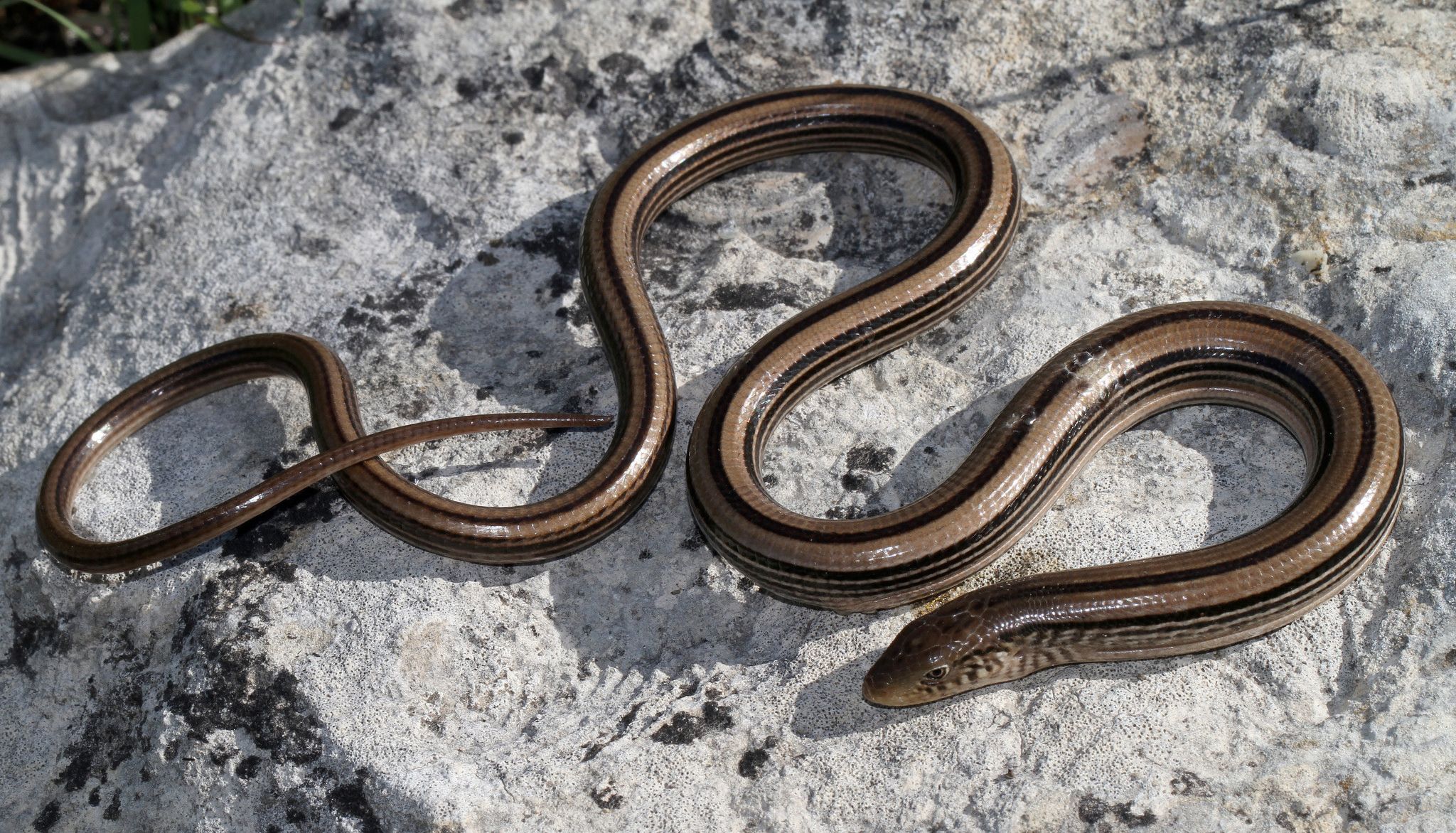
120 spp.
characteristics
has all characteristics of lizard (moveable eyelids, external ear)
long & have shiny scales underlined with bony plates (osteoderms)
autotomize their tails (which are ~2/3--3/4 of whole body)
highly terrestrial & semi-fossorial
reproduction
mostly oviparous
some ovoviviparous
few viviparous
diet
carniverous
distribution
NA, SA, Europe, Asia
Teridae (“whiptails & racerunners”)
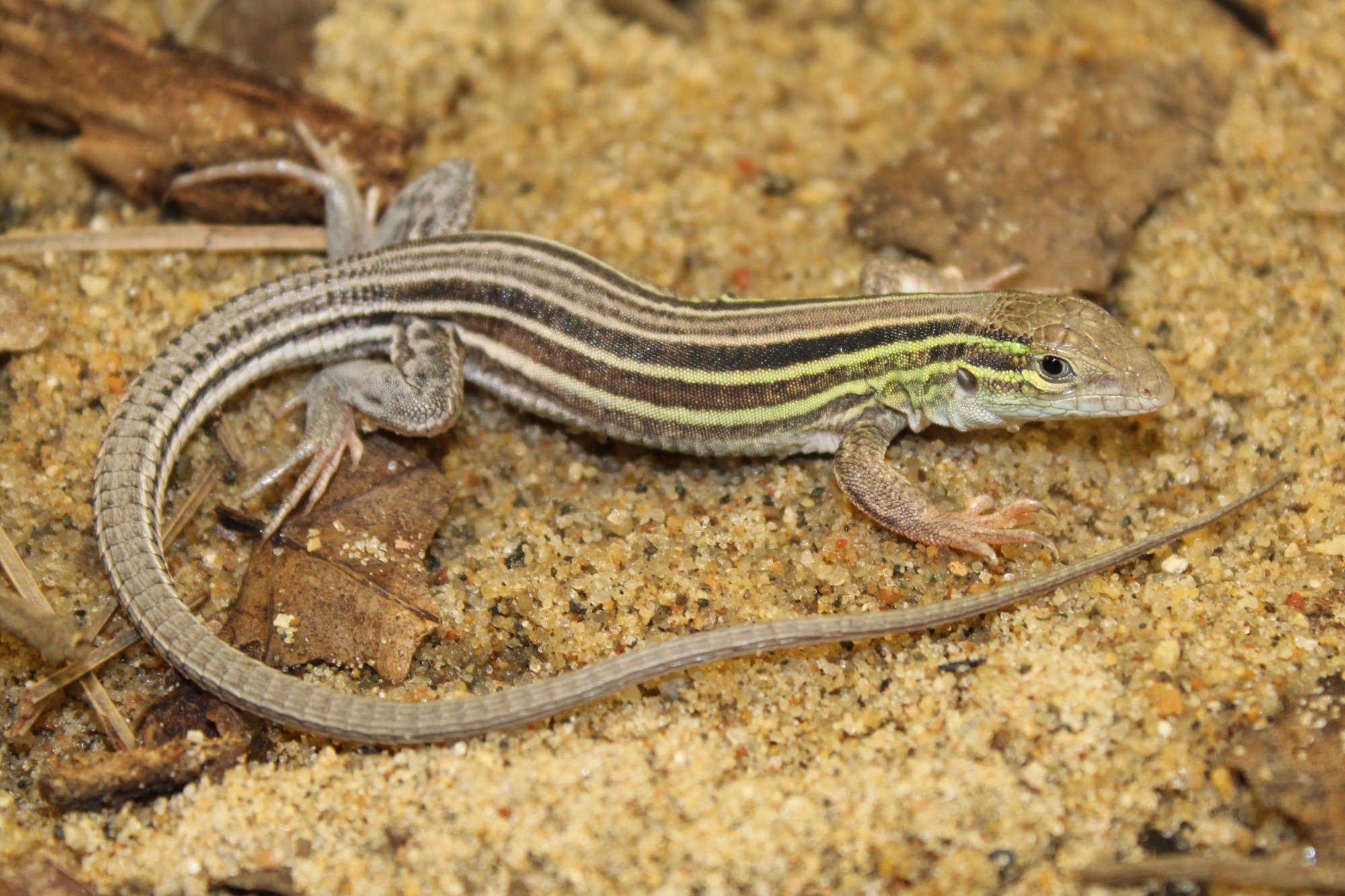
110 spp
characteristics
long, slender bodies with well-developed limbs & very long tail
often have yellow stripes on body
males have blue/green chest during breeding
distribution
only found in NA & SA
terrestrial; sandy prairie
reproduction
oviparous
some spp. are parthenogenic
populations are all female, so all eggs laid are unfertilized & clones of the mother
six-lined racerunner is NOT PARTHENOGENIC
Scincidae (“skinks”)


largest of all lizard families (1200 spp.)
characteristics
osteoderms give them stiff & shiny bodies
autotomize tails
distribution
highly varied
terrestrial, semi-fossorial, diurnal, etc.
everywhere except Antarctica
reproduction
oviparous, ovoviviparous, viviparous
diet
insectivorous
Order Squamata (“snakes”)
3000 spp.
characteristics
immovable eyelids
legless
no external ears
Jacobson’s organ (tongue-flicking)
left lung either entirely absent or highly degenerate
distribution
highly varied habitats (terrestrial, arboreal, etc.)
reproduction
mostly oviparous, but can be other two
Viperidae (“vipers”)

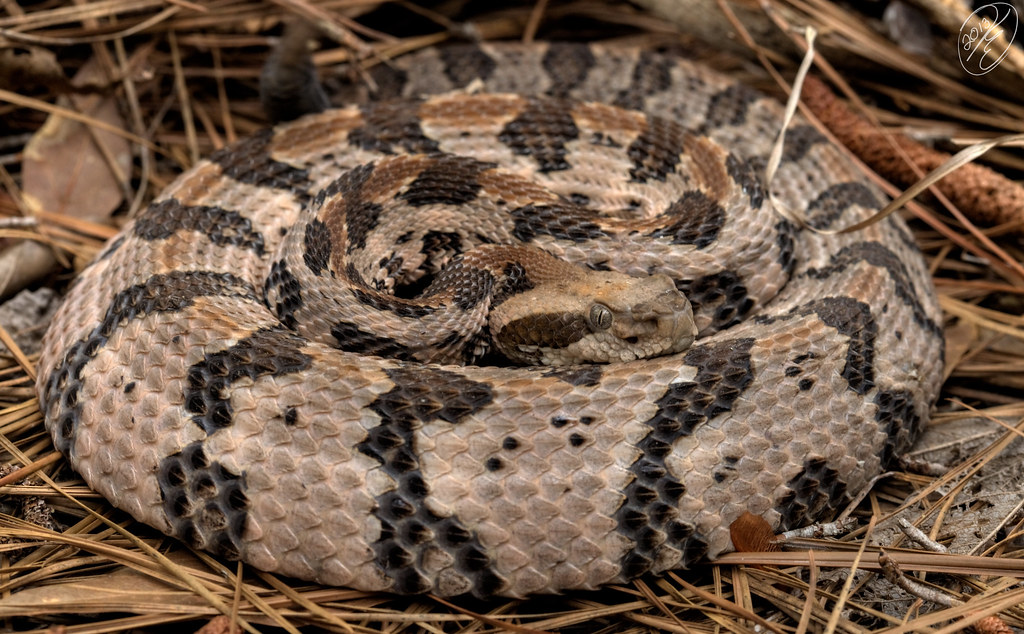
215 spp.
characteristics
long hinged fangs with a hemotoxin (swelling & hemorraging)
cobras have a neurotoxin (central nervous system)
broad heads & stocky bodies
Loreal pit organ senses heat
habitat
terrestrial with wide variety of habitats
NA, SA, Europe, Africa, Asia
reproduction
viviparous
diet
carniverous
Colubridae (“snakes”)
was 2000, but now 650 spp.
characteristics
can be 7in -- 12ft
distribution
terrestrial & aquatic
reproduction
oviparous
ovoviviparous
Natricidae (“snakes”)


200 spp.
distribution
mostly tied to aquatic environments
reproduction
viviparous
ovoviviparous
diet
carnivorous
Dipsadidae (“snakes”)
700 spp.
characteristics
small-medium
from New World
distribution
secretive; hides under cover
reproduction
oviparous
diet
diverse (invertebrates, amphibians, etc.)
Reproduction & Life Histories
fertilization can happen inside/outside of female
development can be direct/indirect
Gametogenesis & Ovulation
most amphibians, 2 sexes required
reproductive timing has internal controls
ultimately coordinated by environment (temp & photoperiod change)
Gametogensis
division & growth of gametes within ovaries & testes through hormonal activation
Vitellogensis
accumulation of nutrients in cytoplasm of developing egg
rapid growth of oocytes (egg 10-100x size)
Ovulation
occurs when follicular & ovarian walls rupture
releases ova into oviduct
as eggs pass through oviduct, protective membrane are deposited around them
number of layers is spp. specific
amphibian eggs are anamniotic
eggs expelled in gelatinous masses or strings
Fertilization
penetration of sperm & fusion of male & female pronuclei
many sperm can reach the egg, but only one will penetrate it
salamanders have polyspermic fertilization
sperm heads (acrosomes) digest eggs membranes, making tiny hole
sperm pronuclei moves into ova cytoplasm; fusion
2 types
external
normal for Sirenidae & Cryptobranchidae, and most Anurans
internal
found in other salamander families
external
simultaneous shedding of eggs & sperm into water
constrain where eggs are laid
frogs: males grasp female in amplexus so their cloacas align
salamanders: either amplexus or male follows female to deposit
inguinal amplexus
male has front legs around female’s upper waist (under arms)
cephalic amplexus
male’s hind legs wraps around female’s head
internal
few frog spp. (Pacific NW), Salamandroidea salamanders, all caecilians
allows eggs to be laid in spot & time of choice
frogs: hemipenis delivers sperm to female cloaca
salamander: spermatophores deposited externally
proteinaceous pedicel capped by sperm packet
spermatheca
sperm storage in series of tubules on cloaca’s roof
Reproduction without Fertilization
asexual reproduction
without male contributions
100% female populations in some taxa
2 types
Hybridogenesis: progeny only transmits female chromosome; all female populations
Gynogenesis: diploid/triploid egg only activated by sperm; no male chromosomes incorproated into embry
only female offspring
fathers from 5 specific spp.
Jefferson salamander, blue spotted salamander, tiger salamander, smallmouth salamander, streamside salamander
Gynogenesis
“unisexual” hybrid Ambystoma complex
5 MYA
ploidy # varies
17 different combos
e.g. 2n, 3n, 4n, 5n (n = copies of genetic contribution)
if 4n with 4 blue spotted salamander & 1 Jefferson, will look more like blue spotted
Parental Care
any form of post-egg laying parental behaviour that increases offspring survival at some expense of parent
most amphibs show no parental care aside from nest construction
represented by a variety of behaviours
nest, egg, or young attendance/guarding
egg brooding
egg, larval, or hatchling transport
feeding of young
Development
Exotrophic
limited amount of yolk; allows females to lay more, but smaller eggs (quantity > quality)
larvae hatch quickly, but must feed themselves
Metamorphosis
shift from embryonic & larval stage to mature terrestrial stage
initiated hormonally, but environment also plays a role (crowding, predation, food availability, etc.)
Paedomorphosis
retention of juvenile characteristics as adults
two types
progenesis: accelerated sexual maturity relative to stomatic growth
neoteny: slowing of stomatic growth with onset to sexual maturity
Growth
addition of enw tissue in excess oif what was lost in damaged tissue
two types
embryonic
increase when high quality food is in abundance
influenced by temp (higher = faster development; not too extreme though)
juvenile
much slower because of unpredictable food & environment
GROWTH IN AMPHIBIANS IS INDETERMINATE/NEVER-ENDING
Age
intervals (periodicity & not age) are important
sexual maturity (4 months -- 7 years)
Embryogenesis (can be truncated in Scaphiopodidae)
larval period → metamorphosis
Dynamics of Reptilian Reproduction
multitude of patterns geared to the right environment for offspring
all temperate spp. are cyclic
tropical spp. cyclic or acyclic
2 patterns (temperate salamanders)
winter/spring mating & egg disposition (Ambystomatids)
late summer/fall mating & spring egg disposition (Plethodontids)
mate attraction & selection
location usually not a problem
reproduction more efficient within home range (sometimes movement is necessary)
courtship is key
female-heavy investment in gametes = most fit mate
Reproduction & Life Histories of Reptiles
major difference in reptilian reproduction compared to amphibians
all have internal fertilization
direct development
amniotic egg
development can occur on much drier land
Gametogenesis & Ovulation
Vitellogenesis very important in egg-laying vertebrates
accumulation of nutrients → yolk
vitellogenin selectively absorbed by oocytes & enzymatically converted to yolk proteins (pinocytosis)
Cleidoic (shelled) egg
prevents desiccation & contamination by environmental pathogens
creates own aquatic environment
by folding & curling, reptile embryo can be very long
3 extraembryonic membranes are formed (no need to know function)
Allantois
Chorion
Amnion
Fertilization & Copulation
copulatory organs
turtle & crocodilians: a penis of spongy connective tissue erects & retracts via vascular pressure (similar to mammals)
tuataras don’t have copulatory organs
squamates: penis lost & later replaced by hemipenis
sperm storage
delayed fertilization → females can mate with more than one male → multiple progeny
sperm storage tubules on upper-mid section of oviducts
mechanism for expelling sperm from these tubules is unknown
Reproduction without Fertilization (reptiles)
Asexual
1 type in reptiles
parthenogenesis
females reproduce without sperm
inheritance is clonal
Parental Care
pre-depositional
involves quantity & size of egg components (egg components = eggshell, protein, lipids, yolk [oviparous reptiles])
hatchling turtles & crocodilians have 50-70% more lipids than required
post-depositional
selection of best sites
live-bearing
20% of all lizards & snakes
ovoviviparous
holds eggs much longer than oviparous spp.
embryos can be supported entirely by egg yolk
embryos can absorb some nutrients through oviducts
viviparous
placenta-like structure transfers nutrients to developing embryo
Embryo Development
direct development in all reptiles
clutch & egg size msy be proportional to body size
larger female = larger eggs & clutch
reptilians that develop from terrestrial egg
humidity (more important for leather eggs)
temperature (ATR)
temperature-dependent sex determination (TSD)
widespread in reptiles
found in all crocodilians, tuataras, & 11 spp. of turtles & squamates
average temp during 2nd trimester
crocs & lizards: male at high temps
turtles: females at high temps
Growth
2 growth pulses
embryonic
increases when yolk is available & decreases with lower Te
juvenile
much slower due to unpredictable food & environment
Age
similar to amphibians (periodicity > age)
conception → hatcling/birth
sexual maturity
reproductive senility
reproductive periodicity very important
longevity can be great for some reptiles
Dynamics of Reproduction
mate attraction & selection
most fit male >>>
territory more important because of reduced need to breed
courtship:
visual signals are important, but also tactile & chemosensory receptors involved